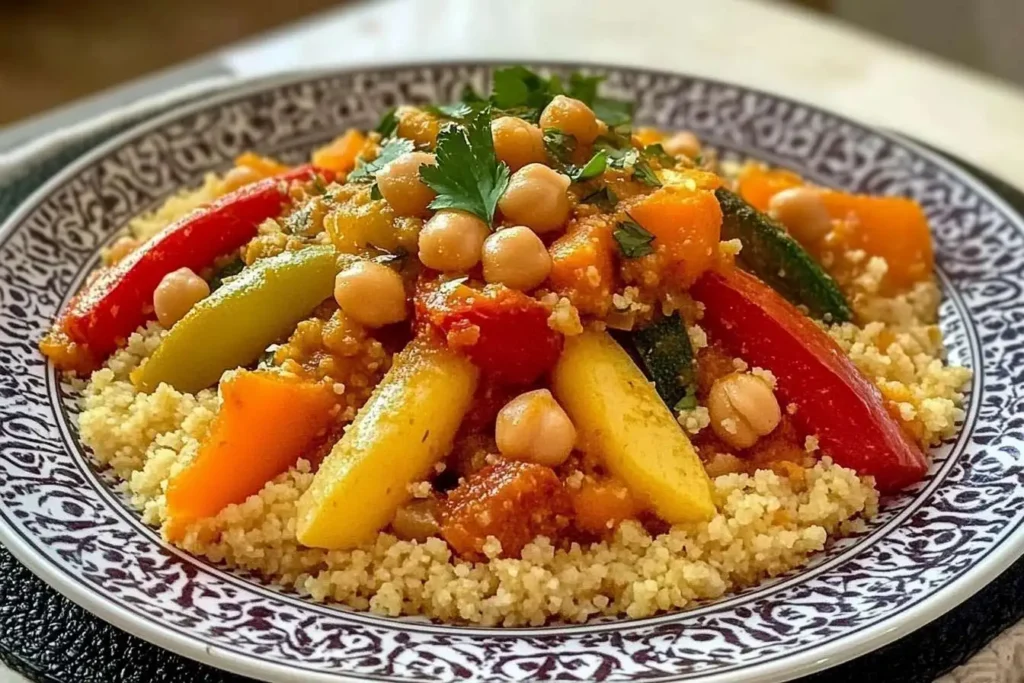Moroccan couscous isn’t just food—it’s an experience, a tradition, and a symbol of hospitality. Found at the heart of Moroccan cuisine, this dish brings families together around a large, steaming platter filled with tender vegetables, aromatic spices, and perfectly fluffy couscous grains.
Unlike instant couscous, authentic Moroccan couscous is steamed to perfection, allowing it to absorb the rich, flavorful broth that makes every bite irresistible. Whether prepared for a casual family dinner or a festive gathering, couscous is a versatile dish that can be adapted to different flavors, proteins, and dietary preferences.
In this guide, you’ll learn how to make traditional Moroccan couscous step by step, with expert tips to ensure light, fluffy grains and a deeply flavorful broth. Let’s bring a taste of Morocco into your kitchen!
Table of Contents
What Makes Moroccan Couscous So Special?
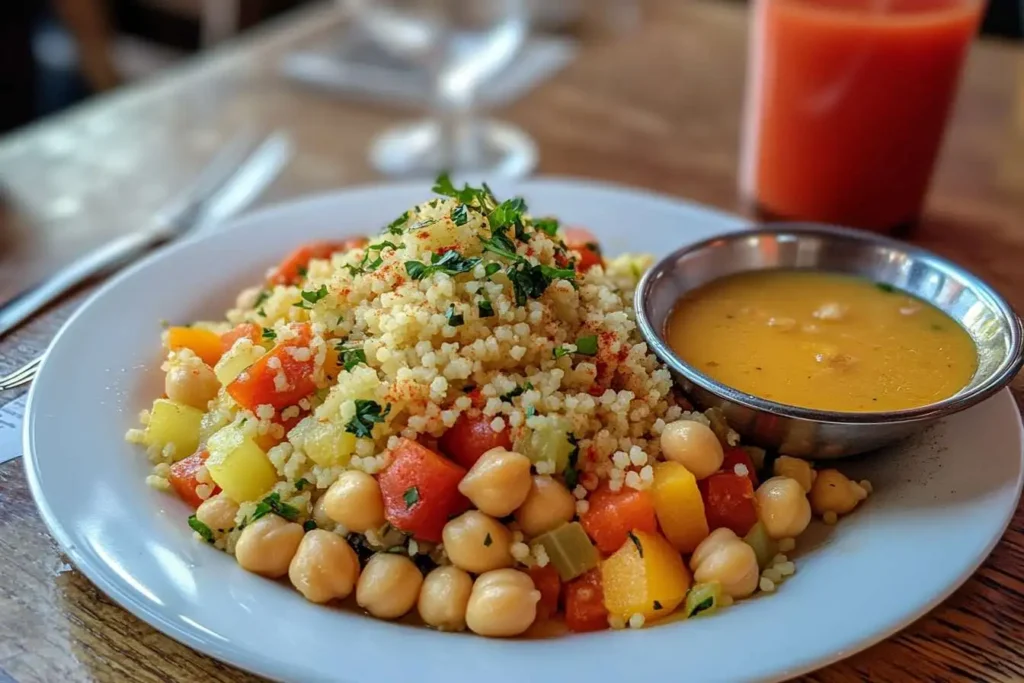
Moroccan couscous is more than just a dish—it’s a reflection of centuries-old traditions, regional influences, and communal dining. Known as “seksu” in Moroccan Arabic, it’s a staple of Friday family gatherings and festive occasions, where it’s served on a large platter for everyone to share.
How Moroccan Couscous Differs from Other Types
Not all couscous is the same! While instant couscous is common in supermarkets, traditional Moroccan couscous is steamed multiple times, giving it a light, fluffy texture. Here’s how it compares to other varieties:
- Moroccan Couscous: Tiny, delicate grains that absorb flavors beautifully. Traditionally steamed over a rich broth.
- Israeli (Pearl) Couscous: Larger, chewy grains, often toasted for a nutty flavor. Cooks more like pasta.
- Lebanese Couscous: The largest variety, resembling small pasta pearls, requiring a longer cooking time.
A Dish Steeped in Tradition
Couscous is traditionally served with:
✔ Slow-cooked meats (like lamb or chicken) for deep, rich flavor.
✔ Seasonal vegetables simmered in a fragrant broth.
✔ Sweet & savory elements, like caramelized onions, raisins, and almonds.
Whether prepared for a simple meal or a grand celebration, Moroccan couscous is a true comfort food, deeply rooted in Moroccan culture and hospitality.
Want a seasonal twist? Try adding roasted pumpkin or butternut squash to your couscous for a sweet and savory balance. For more pumpkin-inspired dishes, check out our pumpkin breakfast recipes.
How to Make the Best Moroccan Couscous: Step-by-Step Guide + Pro Tips
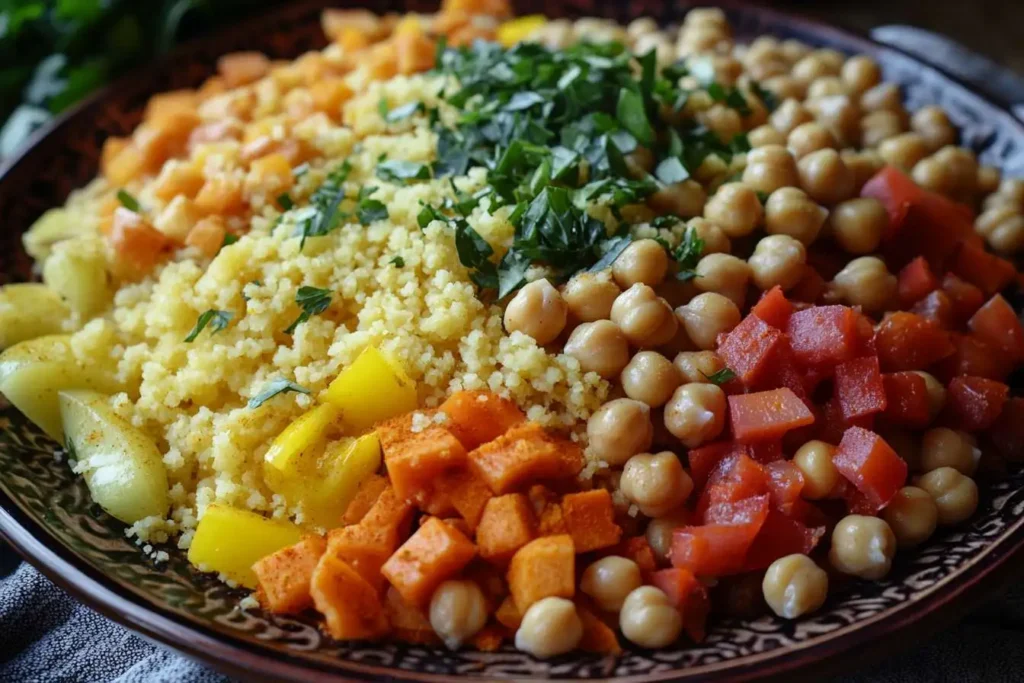
Making Moroccan couscous the traditional way is all about building layers of flavor and achieving light, fluffy grains. While it may seem time-intensive, the process is straightforward and absolutely worth it.
What You’ll Need (Quick Ingredient Overview)
✔ Couscous grains – Fine semolina for authentic texture
✔ Protein – Lamb, chicken, or chickpeas for a vegetarian option
✔ Vegetables – Carrots, zucchini, pumpkin, tomatoes
✔ Spices – Turmeric, saffron, cinnamon, ginger, cumin
✔ Herbs & Garnishes – Fresh parsley, cilantro, raisins, almonds, harissa
👉 Find the full ingredient list and exact measurements in the printable recipe card below!
The Secret to Perfect Moroccan Couscous
Use High-Quality Spices – Fresh saffron, turmeric, and cinnamon bring out the depth of flavors in this dish.
Steam, Don’t Just Soak – For the best texture, traditional couscous is steamed three times rather than soaked like instant couscous. This gives it a light, fluffy consistency that absorbs the broth beautifully.
Build a Flavorful Broth – Moroccan couscous is defined by its aromatic, spiced broth, enriched with slow-cooked meat, vegetables, and fragrant spices.
Balance Sweet & Savory – The raisins and almonds contrast beautifully with the warm, spiced broth, creating the signature Moroccan flavor.
Quick Customization Options
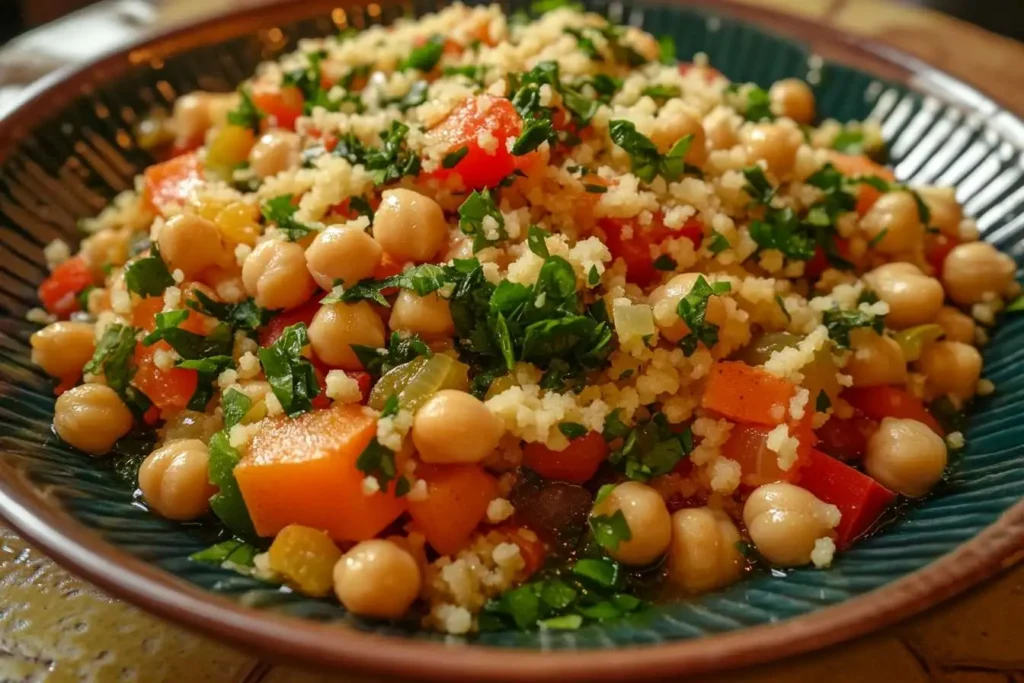
✅ Make It Vegan – Use chickpeas instead of meat and swap chicken broth for vegetable broth.
✅ Gluten-Free? – Traditional couscous contains semolina, but you can substitute quinoa or millet.
✅ For a Sweeter Touch – Add dried apricots, dates, or a drizzle of honey to bring Moroccan-style sweetness.
✅ Love a Spicy Kick? – Stir harissa into the broth or serve it on the side.
If you love slow-cooked meals, you can adapt Moroccan couscous for a crockpot by letting the flavors develop over time. For more slow-cooked meal ideas, explore our crockpot breakfast recipes.
Printable Recipe Card for Authentic Moroccan Couscous
Print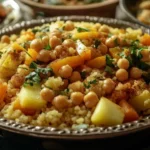
Authentic Moroccan Couscous
- Total Time: 1 hour 30 minutes
- Yield: 6 servings
Description
This traditional Moroccan couscous recipe brings together fluffy steamed semolina, aromatic spices, and a medley of slow-simmered vegetables. Served with tender meat or enjoyed as a vegetarian dish, it’s a comforting meal perfect for gatherings or weeknight dinners.
Ingredients
For the Couscous
2 cups fine semolina couscous
1 ½ cups warm water
1 tablespoon olive oil
½ teaspoon salt
For the Broth & Vegetables
1 lb lamb or chicken (or 1 ½ cups cooked chickpeas for a vegan option)
1 large onion, diced
3 cloves garlic, minced
2 large carrots, peeled and cut into chunks
2 medium zucchini, cut into thick slices
1 cup pumpkin or butternut squash, diced
2 medium tomatoes, chopped
½ cup canned or cooked chickpeas (optional)
3 tablespoons olive oil
4 cups chicken or vegetable stock
Spices & Seasonings
½ teaspoon saffron threads (or ¼ teaspoon ground saffron)
1 teaspoon turmeric
1 teaspoon ground ginger
½ teaspoon ground cinnamon
½ teaspoon ground cumin
Salt & black pepper to taste
Garnishes
½ cup raisins or sultanas
½ cup toasted sliced almonds
2 tablespoons chopped fresh parsley or cilantro
Harissa paste (optional, for spice lovers)
Instructions
1 Prepare the Broth & Meat
In a large Dutch oven or deep pot, heat 3 tablespoons olive oil over medium heat.
Add onions, garlic, and meat (or chickpeas for a vegan version), and sauté for 5 minutes until lightly browned.
Stir in saffron, turmeric, ginger, cinnamon, cumin, salt, and pepper, and cook for 1–2 minutes until fragrant.
2 Simmer the Vegetables
Add carrots, zucchini, pumpkin, tomatoes, and optional chickpeas.
Pour in 4 cups of stock, cover, and let simmer for 30–40 minutes until the vegetables are tender and the broth is rich.
3 Steam the Couscous the Traditional Way (Recommended for the best texture!)
Place 2 cups of couscous in a large bowl. Drizzle with ½ cup warm water and ½ teaspoon salt, then fluff with your fingers.
Transfer to the top section of a couscoussier (or use a steamer over boiling water) and steam for 15 minutes.
Remove, transfer back to the bowl, and mix in 1 tablespoon olive oil. Repeat the steaming process two more times for fluffy grains.
🔥 Quick Method (For Pre-Steamed Couscous): Pour 1 ½ cups boiling water over 2 cups couscous, cover, and let sit for 5 minutes. Fluff with a fork.
4 Prepare the Garnishes
In a small saucepan, simmer ½ cup raisins with 1 teaspoon cinnamon and 1 tablespoon butter for 5 minutes.
Toast ½ cup almonds in a dry pan over medium heat for 2–3 minutes until golden brown.
5 Assemble & Serve
Spread the couscous on a large serving platter, making a well in the center.
Arrange the cooked meat and vegetables over the couscous.
Pour some of the flavorful broth over everything to keep it moist.
Sprinkle with raisins, almonds, and fresh parsley. Serve with harissa on the side for a spicy kick.
Notes
For an extra fragrant broth, add a pinch of ground coriander or paprika.
Vegetarians can skip the meat and double the chickpeas for a protein-rich meal.
If you prefer a sweeter touch, add chopped dried apricots or caramelized onions.
Leftovers can be stored in an airtight container for up to 3 days in the fridge.
- Prep Time: 30 minutes
- Cook Time: 1 hour
- Category: Main Dish
- Method: Steaming, Simmering
- Cuisine: Moroccan
Nutrition
- Calories: 340 kcal
- Sugar: 6g
- Sodium: 520mg
- Fat: 9g
- Saturated Fat: 1g
- Unsaturated Fat: 7g
- Trans Fat: 0g
- Carbohydrates: 50g
- Fiber: 8g
- Protein: 15g
- Cholesterol: 25mg
Frequently Asked Questions About Moroccan Couscous
What is Moroccan couscous made of?
Moroccan couscous consists of fine semolina wheat granules that are steamed until light and fluffy. It’s typically served with a stew of meat (such as lamb or chicken) and vegetables, all seasoned with a blend of aromatic spices like cumin, turmeric, and cinnamon. Variations may include dried fruits and nuts for added flavor and texture.
Is Moroccan couscous healthy?
Yes, Moroccan couscous can be a healthy dish. The couscous grains provide complex carbohydrates, offering sustained energy. When paired with lean meats and a variety of vegetables, it becomes a balanced meal rich in fiber, protein, vitamins, and minerals. However, portion sizes and specific ingredients can affect its overall nutritional profile.
Can I make Moroccan couscous without a couscoussier?
Yes! While a couscoussier (traditional steamer) gives the best texture, you can use a fine-mesh steamer or the quick soak method:
Place couscous in a bowl, pour boiling water or broth over it.
Cover for 5 minutes, then fluff with a fork before serving.
What does Moroccan couscous taste like?
Moroccan couscous has a mild, slightly nutty flavor from the semolina grains. The taste is significantly influenced by the accompanying stew, which is often savory and aromatic, featuring tender meat, a medley of vegetables, and a harmonious blend of spices. The addition of ingredients like dried fruits can introduce subtle sweetness, creating a complex and satisfying flavor profile.
Can Moroccan couscous be made vegetarian or vegan?
Absolutely! Moroccan couscous can be adapted to suit vegetarian or vegan diets. By omitting meat and focusing on a rich assortment of vegetables, legumes like chickpeas, and plant-based broths, you can create a flavorful and satisfying vegetarian or vegan couscous dish. Spices and herbs play a crucial role in enhancing the taste in the absence of meat.
Experience the Magic of Moroccan Couscous
Moroccan couscous is more than just a dish—it’s a cultural experience, a symbol of hospitality, and a celebration of flavors. From its light and fluffy texture to the rich, aromatic stews that accompany it, this traditional meal brings people together around the table in a way few dishes can.
Whether you prepare it the traditional way in a couscoussier or opt for a quicker modern method, couscous is a versatile, wholesome, and satisfying meal that can be customized to suit any taste or dietary preference. With every bite, you get a taste of Morocco’s rich history, warm spices, and vibrant culinary traditions.
Now that you’ve explored the world of Moroccan couscous, why not bring it into your own kitchen? Try making a batch, experiment with flavors, and share it with family and friends—the way it’s meant to be enjoyed!

